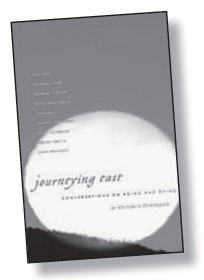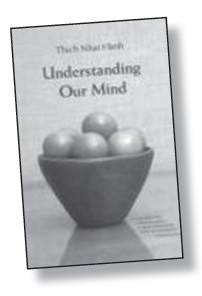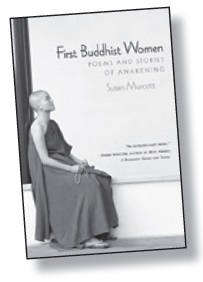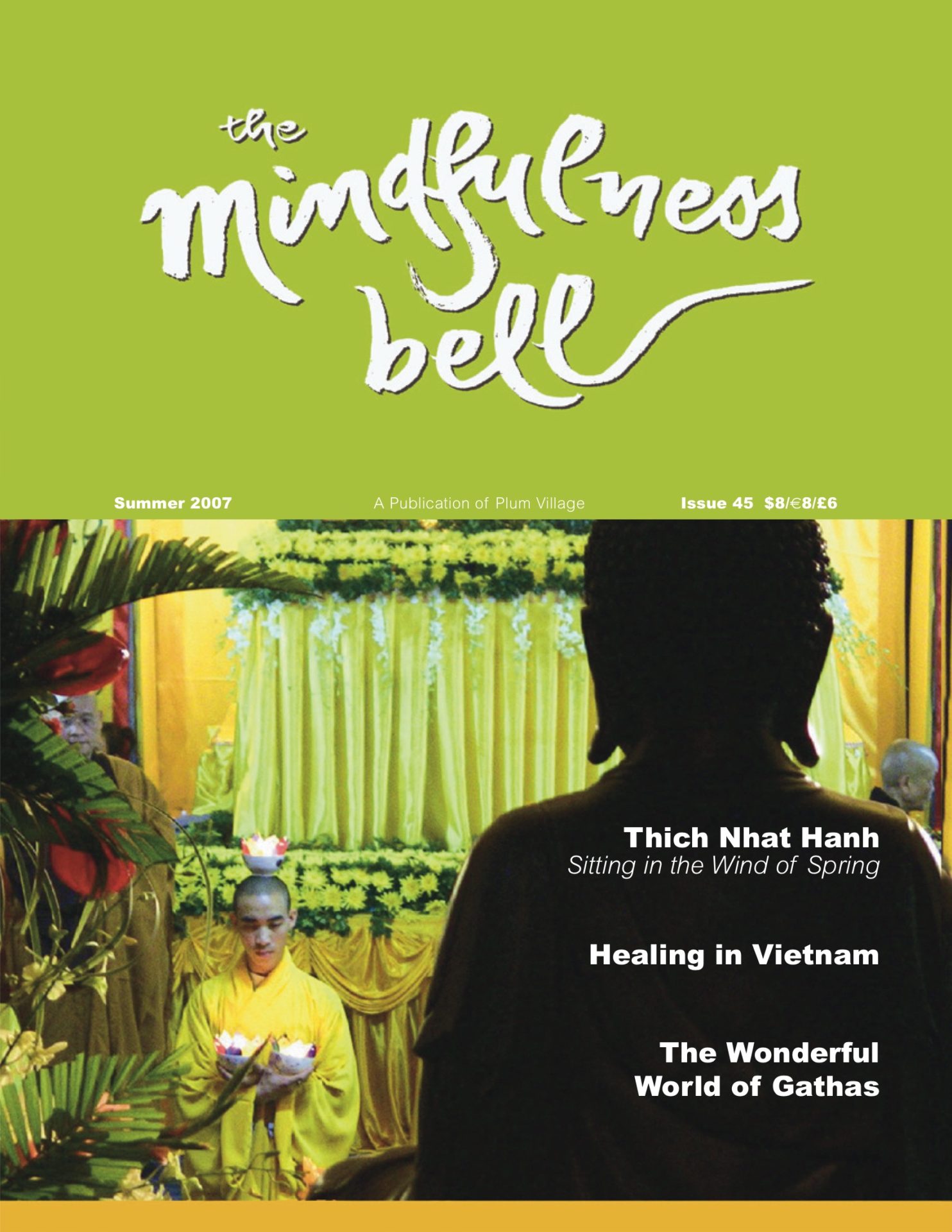
Journeying East
Conversations on Aging and Dying
By Victoria Jean Dimidjian
Parallax Press, 2004
Reviewed by William Menza
Journeying East is an extraordinary primer on the spiritual, psychological, and physical components of getting old and dying — and living a mindful life. Author Victoria Jean Dimidjian is a professor of education at Florida Gulf Coast University and founding member of the Naples,

Journeying East
Conversations on Aging and Dying
By Victoria Jean Dimidjian
Parallax Press, 2004
Reviewed by William Menza
Journeying East is an extraordinary primer on the spiritual, psychological, and physical components of getting old and dying — and living a mindful life. Author Victoria Jean Dimidjian is a professor of education at Florida Gulf Coast University and founding member of the Naples, Florida Community of Mindfulness. She has assembled a profound and practical collection of insights from Ram Dass, Frank Ostaseski, Joan Halifax, Thich Nhat Hanh, Michael Eigen, Rodney Smith, Sister Chan Khong, John Welwood, and Norman Fischer.
In interviews with Dimidjian these teachers transmit a remarkable blend of Eastern and Western wisdom. They tell us that to understand death or prepare for it we have to be deeply in touch with what is happening in the present moment, even as the body dissolves.
Thich Nhat Hanh says: “There is no journeying east, there is no journeying west. We live in the now.” Frank Ostaseski tells us: “You cannot go into the room where someone is dying and not pay attention. Everything is pulling you into the moment.” Norman Fischer says: “I think that death is our greatest teaching. Dying is a way of living, a meditation practice, the most fundamental and most profound of all meditation practices.”
We are cautioned by John Welwood to “be careful with what the death industry might be trying to package for us about knowing what death is all about.” If you have an idea about “a good death” you are creating expectations that will interfere with your unique experience of death. We each need to find our own individual death. “This is an important moment in your life — the final passage — and you don’t want to “live someone else’s version of that!”
The book has an appendix on Internet resources and another on suggested activities such as writing or videotaping a living will, an advance health directive, a durable power of attorney, a will, a good-bye letter. To demystify death and make it normal and natural Dimidjian suggests taking classes on aging and dying, visiting a local hospice, and talking about death with your family. This reminds me of the Meditation or Contemplation on Death, like the one detailed in Thay’s book The Blooming of a Lotus, where we envision the various stages of a decaying dead body — one day this is what we will be.

Understanding Our Mind
By Thich Nhat Hanh Parallax Press, 2006 Softcover, 251 pages
Reviewed by Judith Toy
The first time I encountered the Fifty Verses on the Nature of Consciousness was in Thich Nhat Hanh’s previous book on this subject, Transformation at the Base. About midway through the text, I got into trouble trying to intellectually grasp the teachings. While I did finish the book, it was with scant understanding. Now Thich Nhat Hanh has made these teachings from the Abhidharma (literally super-Dharma) more accessible. In Understanding Our Mind, Thay provides an in-depth look at this primary text of original Buddhism on the nature of consciousness, applying it to modern life. The verses, and thus the book, are divided into six sections: store consciousness, or the seed bed; manas, or the mind root; mind consciousness; sense consciousness; the nature of reality, or non-self; and the path of practice.
Breathing in, I approached this new book by first reading the Fifty Verses. Breathing out, I made some notes. For example, verse Ten refers to the five universal mental formations. For handy reference, I penciled them into the margin: 1) contact; 2) attention; 3) feeling; 4) perception or conceptualization; and 5) volition. I thought of how these work in succession: When we smell a tasty food, the odor commands our attention: contact and attention. Often, then, we feel hungry: feeling. Next we approach the stove and take the lid off the pan. We see the food: perception or conceptualization; and finally, we decide to taste it: volition.
Mind root, manas, the verses explain, has its interbeing with these five universals. In fact, manas inter-exists with all thinking and affliction. Further, all that stems from the mind root is indeterminate and obscured. In his commentary, the author uses the metaphor of the ocean to explain indeterminate and obscured: “The ocean is salty, so all drops of water in the ocean are salty at the same time.”
Verse Twenty-Two refers to the stages of the bodhisattva path. Many of us have experienced the first stage of the bodhisattva path, transforming afflictions. And perhaps when we are well focused, we enjoy a preview of the tenth stage, transforming our belief in a separate self, nirvana.
Understanding Our Mind contains the central illumination of Mahayana Buddhism — that we are all buddhas-to-be. Much more than an intellectual exercise, Thich Nhat Hanh’s discourse is a deep inspiration, underlining for those of us raised in the Christian tradition our early, child-like belief in resurrection. Afflictions, we learn, are none other than enlightenment! We can see how this great mirror wisdom works in our own lives.
When our beloved says something that hurts us, Thich Nhat Hanh invites us to practice by closing our eyes, breathing mindfully in and out, and imagining the two of us one hundred years from now. After three breaths, when we open our eyes, we’ll no longer feel hurt; instead, we’ll want to hug our beloved. What I find continually amazing is Thich Nhat Hanh’s ability to bring liberation into daily life. When we go from being hurt to being mindful and loving, he tells us we are touching nirvana!
“Samsara [the endless cycle of birth and death and its inherent suffering] and suchness [the nature of nirvana] are not two; they are one and the same.” Once we realize this, we can smile “the smile of non-fear.” Even in pain, when we are centered, we can give ourselves fully to peace.

First Buddhist Women
Poems and Stories of Awakening
By Susan Murcott
Parallax Press, 2006
Reviewed by Phillip Toy
“Why has Gautama come here? To take away our sons and make our daughters widows!” — The Mahavagga
This masterful re-issue of a 1991 original — ten years in the making, five of which it took to write — showcases Susan Murcott’s scholarship, coupled with considerable poetic sensitivities. This marriage of talents seamlessly brings to life a pivotal period for buddhadharma in general, but more specifically, the religious, social, and political context for Buddhism’s first enlightened women. The common threads of loss, estrangement, marginalization, madness and, finally, liberation are eloquently and simply woven and illustrated in the enlightenment poetry (the Therigatha) of eight of the most important groups of women of that day.
Pajapati, the Buddha’s aunt and foster mother who raised him, and consequently lost him to “the homeless life,” became the first ordained woman and the first woman teacher. She founded the first order of nuns. She writes: “I have reached the state where everything stops.” Early in her nunhood she challenged her famed foster son, via his chief disciple, Ananda, on the first of The Eight Special Rules: even the most senior nun must bow down before the most novice monk.
The privileged Patacara (meaning “cloak walker”) having lost her son and entire prominent family in a fire, went mad and wandered in circles dragging her clothes to ribbons till they fell off her body. Townsfolk drove her off with sticks and rubbish. Gautama tracked her down: “Sister, recover your presence of mind!” She says, “I concentrated my mind the way you train a good horse.” Eventually Patacara’s following was second only to Pajapati’s.
The pabbajita, or wandering heretics and disciples, some of whom were forest-dwellers, write a curious mix of diligence and desperation. Frequently, as with the other groups portrayed, traumatic personal events were springboards for deep religious experiences and new beginnings — even, indeed, enlightenment: “I have ended the hunger of gods and humans, and I will not wander from birth to birth. I have no thought of becoming.”
Whether wise woman and teacher, mother, wife, old woman, prostitute, courtesan or beautiful woman — each role’s poetry describes its unique path to yet a common destination. Murcott’s ardent, scholarly grasp of her material is polished by an unspoken, intensely personal treatment that hints at her own journey — obviously similar in many ways to her book’s subjects’.
Supported as it is throughout by copious notes and footnotes, by an exhaustive bibliography including unpublished theses, an index of poems and poets, a pithy glossary, and a striking appendix of “The Rules of the Nun’s Sangha,” this volume belongs on every serious Buddhist student’s bookshelf. A compact and artful explication of the Therigatha, sixth century B.C.E. enlightenment poetry of the Buddhist nuns and the earliest known collection of women’s religious poetry, it delineates the way so many of us come to the Dharma — out of brokenness, irretrievable loss, confusion and sorrow.
These eloquent lines, which appear in some form in almost every poem, express it poignantly: “I remove my shoes/ wash my feet/ sit down beside the Buddha/ I am quenched, I am cool.”

